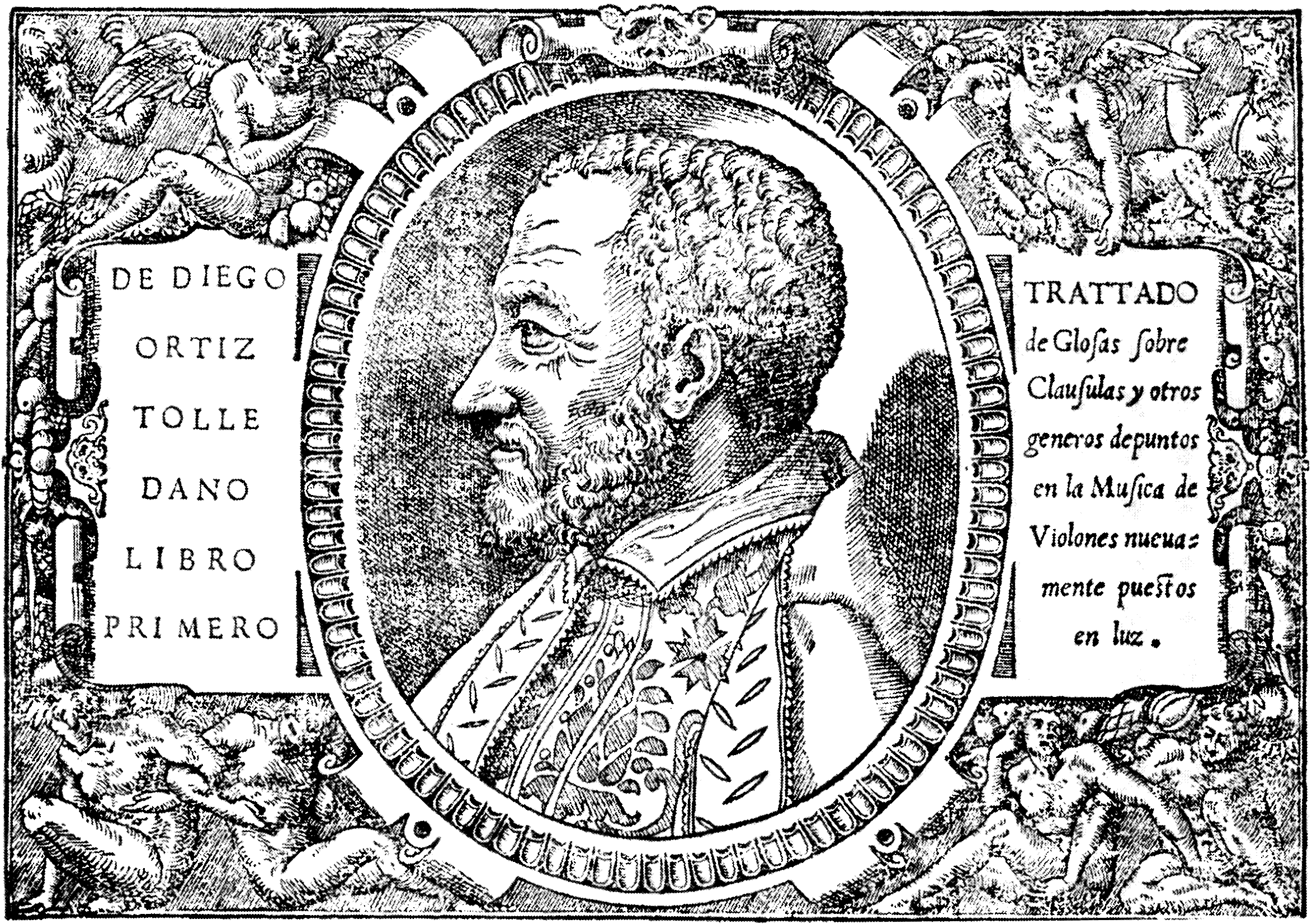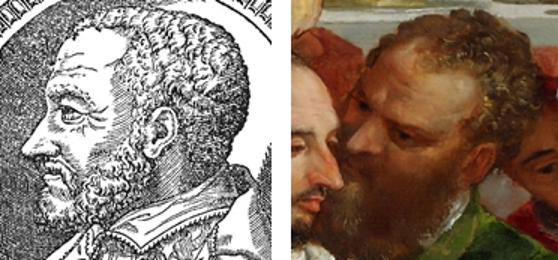Diego Ortiz on:
[Wikipedia]
[Google]
[Amazon]
 Diego Ortiz (c. 1510 – c. 1576) was a Spanish
Diego Ortiz (c. 1510 – c. 1576) was a Spanish
 In 1553 Ortiz was living in the viceroyalty of Naples. Five years later, the third
In 1553 Ortiz was living in the viceroyalty of Naples. Five years later, the third
''El primo(-secondo) libro de Diego Ortiz''
''(click "View options" JPG icon)'' - Biblioteca Nacional de Españ
info
* * {{DEFAULTSORT:Ortiz, Diego 1510s births 1570s deaths Spanish classical composers Spanish male classical composers Spanish music theorists Renaissance composers People from Toledo, Spain
 Diego Ortiz (c. 1510 – c. 1576) was a Spanish
Diego Ortiz (c. 1510 – c. 1576) was a Spanish composer
A composer is a person who writes music. The term is especially used to indicate composers of Western classical music, or those who are composers by occupation. Many composers are, or were, also skilled performers of music.
Etymology and Defi ...
and music theorist
Music theory is the study of the practices and possibilities of music. ''The Oxford Companion to Music'' describes three interrelated uses of the term "music theory". The first is the "rudiments", that are needed to understand music notation (ke ...
in service to the viceroy of Naples
This is a list of viceroys of the Kingdom of Naples. Following the conquest of Naples by Louis XII of France in 1501, Naples was subject to the rule of the foreign rulers, the Kings of France, Aragon and Spain and the Habsburg Archdukes of Austria ...
ruled by the Spanish monarchs Charles V Charles V may refer to:
* Charles V, Holy Roman Emperor (1500–1558)
* Charles V of Naples (1661–1700), better known as Charles II of Spain
* Charles V of France (1338–1380), called the Wise
* Charles V, Duke of Lorraine (1643–1690)
* Infan ...
and Philip II Philip II may refer to:
* Philip II of Macedon (382–336 BC)
* Philip II (emperor) (238–249), Roman emperor
* Philip II, Prince of Taranto (1329–1374)
* Philip II, Duke of Burgundy (1342–1404)
* Philip II, Duke of Savoy (1438-1497)
* Philip ...
. Ortiz published the first manual on ornamentation for bowed string instruments, and a large collection of sacred vocal compositions.
Biography
Very little is known about Ortiz's life. He is believed to have been born in Toledo and probably died inRome
, established_title = Founded
, established_date = 753 BC
, founder = King Romulus (legendary)
, image_map = Map of comune of Rome (metropolitan city of Capital Rome, region Lazio, Italy).svg
, map_caption ...
, where its trail is lost.
 In 1553 Ortiz was living in the viceroyalty of Naples. Five years later, the third
In 1553 Ortiz was living in the viceroyalty of Naples. Five years later, the third duke of Alba
Duke of Alba de Tormes ( es, Duque de Alba de Tormes), commonly known as Duke of Alba, is a title of Spanish nobility that is accompanied by the dignity of Grandee of Spain. In 1472, the title of ''Count of Alba de Tormes'', inherited by G ...
, Fernando Álvarez de Toledo
Fernando is a Spanish and Portuguese given name and a surname common in Spain, Portugal, Italy, France, Switzerland, former Spanish or Portuguese colonies in Latin America, Africa, the Philippines, India, and Sri Lanka. It is equivalent to the G ...
, appointed him maestro di cappella
(, also , ) from German ''Kapelle'' (chapel) and ''Meister'' (master)'','' literally "master of the chapel choir" designates the leader of an ensemble of musicians. Originally used to refer to somebody in charge of music in a chapel, the term ha ...
of the Chapel Royal of Naples
The Chapel Royal of Naples (Italian: ''Cappella Palatina'' or ''Cappella Reale dell'Assunta'') was the sacred musical establishment of the Spanish court in Naples which began with the Aragonese Court of Naples, and continued under the Habsburgs ...
. In 1565 Ortiz still held the post under the Viceroy Pedro Afán de Ribera
Pedro Afán de Ribera, 1st Duke of Alcalá de los Gazules, Virrey y Capitán General de Cataluña y Nápoles (died 1571), also known as Pedro Enriquez Afan de Ribera or Per Afán de Ribera y Portocarrero or Perafán de Ribera y Portocarrero, was a ...
, duke of Alcalá
Duke is a male title either of a monarch ruling over a duchy, or of a member of royalty, or nobility. As rulers, dukes are ranked below emperors, kings, grand princes, grand dukes, and sovereign princes. As royalty or nobility, they are rank ...
. A recent study suggests that Diego Ortiz could have been the model for a very relevant personage in the famous work of Paolo Caliari Veronese "The Wedding at Cana
''The Wedding Feast at Cana'' (''Nozze di Cana'', 1562–1563), by Paolo Veronese, is a representational painting that depicts the biblical story of the Marriage at Cana, at which Jesus miraculously converts water into red wine (John 2:1–11). ...
", based on the instrumental ensemble represented by the painter, the edition date of Ortiz's second book ''Musices liber primus'' in Venice, the repeated confusions and misattributions about this person in the literature down to the present, and the striking resemblance of the painted character with the only known engraved portrait of the musician.
Recent findings reveal that, after his service to the Spanish Neapolitan Court, as Maestro di Cappella
(, also , ) from German ''Kapelle'' (chapel) and ''Meister'' (master)'','' literally "master of the chapel choir" designates the leader of an ensemble of musicians. Originally used to refer to somebody in charge of music in a chapel, the term ha ...
appeared, as "''famigliare''", in the Colonna's Court in Rome, at least from April 1572 to September 1576.
Works
Ortiz published two music books: ''Trattado de Glosas'' in 1553 and ''Musices liber primus'' in 1565.''Trattado de Glossas''
The ''Trattado de Glosas'' (modern Spanish spelling '' Tratado de Glosas'') is considered a masterpiece of literature for theviola da gamba
The viol (), viola da gamba (), or informally gamba, is any one of a family of bowed, fretted, and stringed instruments with hollow wooden bodies and pegboxes where the tension on the strings can be increased or decreased to adjust the pitc ...
. The work was published on 10 December 1553, in Rome
, established_title = Founded
, established_date = 753 BC
, founder = King Romulus (legendary)
, image_map = Map of comune of Rome (metropolitan city of Capital Rome, region Lazio, Italy).svg
, map_caption ...
under the Spanish
Spanish might refer to:
* Items from or related to Spain:
**Spaniards are a nation and ethnic group indigenous to Spain
**Spanish language, spoken in Spain and many Latin American countries
**Spanish cuisine
Other places
* Spanish, Ontario, Can ...
title ''Trattado de glossas sobre clausulas y otros generos de puntos en la musica de violones nuevamente puestos en luz''. The Italian edition was published at the same time, with the title ''Glose sopra le cadenze et altre sorte de punti in la musica del violone''. The Italian edition is full of Hispanicisms, which suggests that Ortiz made this version himself.
''Musices liber primus''
Ortiz published a collection ofpolyphonic
Polyphony ( ) is a type of musical texture consisting of two or more simultaneous lines of independent melody, as opposed to a musical texture with just one voice, monophony, or a texture with one dominant melodic voice accompanied by chords, h ...
religious music in 1565 in Venice
Venice ( ; it, Venezia ; vec, Venesia or ) is a city in northeastern Italy and the capital of the Veneto Regions of Italy, region. It is built on a group of 118 small islands that are separated by canals and linked by over 400 ...
. ''Musices liber primus hymnos, Magnificas, Salves, motecta, psalmos'' includes sixty-nine compositions for four to seven voices, based on plainchant
Plainsong or plainchant (calque from the French ''plain-chant''; la, cantus planus) is a body of chants used in the liturgies of the Western Church. When referring to the term plainsong, it is those sacred pieces that are composed in Latin text. ...
works. They are stylistically conservative for the period, appropriate to the tastes of the dedicatee, Ortiz's employer, Pedro Afán de Rivera, Duke of Alcalá and the Spanish Viceroy in Naples. In the preface to this publication, Ortiz encourages performers to accompany these sacred polyphonic works with instruments, a practice favoured at the time in Spain, and promises future publication of a book of masses which never appeared.
References
* FootnotesSheetmusic
''El primo(-secondo) libro de Diego Ortiz''
''(click "View options" JPG icon)'' - Biblioteca Nacional de Españ
info
* * {{DEFAULTSORT:Ortiz, Diego 1510s births 1570s deaths Spanish classical composers Spanish male classical composers Spanish music theorists Renaissance composers People from Toledo, Spain